Revell's 1/32 scale
Messerschmitt Bf 109 G-6
Part One
by Brett Green
|
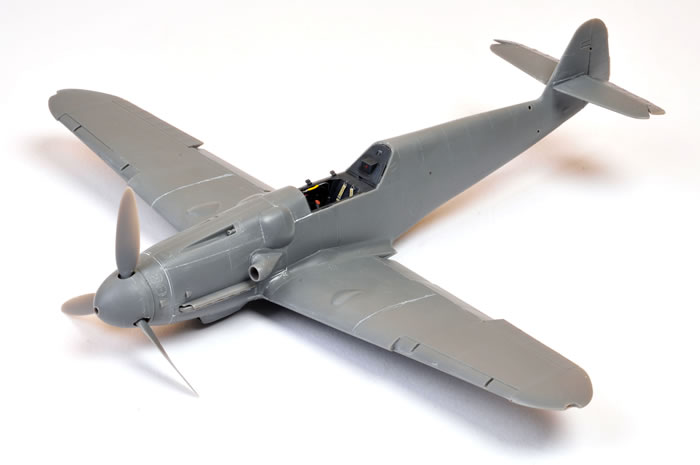
|
Messerschmitt Bf 109 G-6 Late Version
(kit may also be built as early version) |

Revell's 1/32 scale Messerschmitt Bf 109 G-6 will be available online from Squadron
I was lucky enough to receive test shot sprues of the forthcoming all-new 1/32 scale Messerschmitt Bf 109 G-6 a few weeks ago, and I have recently finished basic construction.
This model was built straight from the box for a forthcoming book to be released by ADH Publishing.
Revell's initial release will include parts for an early and a late Bf 109 G-6, including:
-
alternative cockpit parts (different cannon breech covers, alternative footrests, and battery box option behind the pilot's head)
-
both early framed and clear-vision Erla canopies; and two windscreen versions
-
standard and tall tails
-
long and short tail wheel strut and alternate tail wheel well fairings
-
treaded and smooth main wheels
-
Morane mast with clear insulator base and DF loop for late version
-
early and late shell ejector panels under the fuselage
-
alternate starboard side engine cowls (with and without the G-5-style compressor bulge).
The kit is cleverly engineered to allow different panels to be fitted to the engine cowl and fuselage sides, suggesting the possibility of other earlier or later variants. This does mean that there are a few extraneous join seams that do not fall on panel lines, but fit is very good so filling and sanding are minimal.
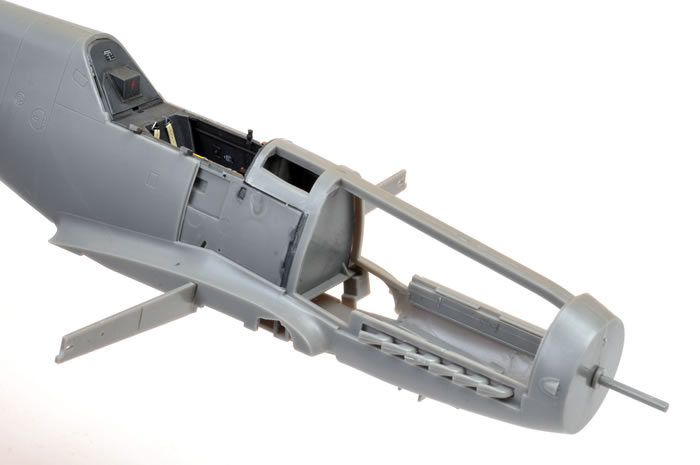
Another unique feature is that the wing wheel bulges are not separate stick-on parts but fully formed on the top and bottom surfaces of the inboard upper wing panels. Also, the internal wheel well sidewalls are split into three parts plus wing spar on each side, resulting in a uniquely realistic depiction of the undercarriage bays without the canvas covers fitted.
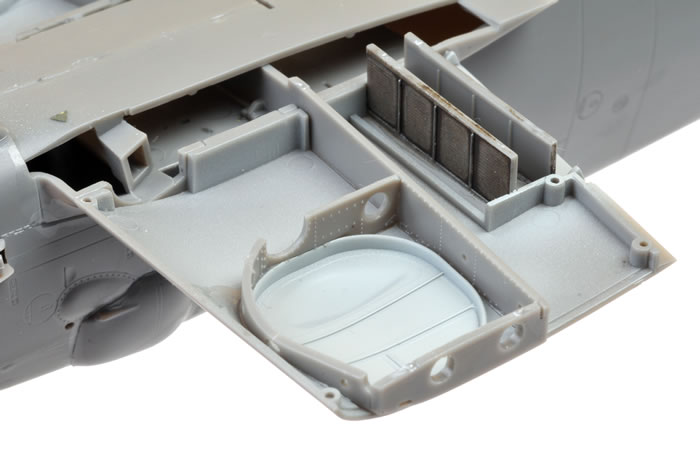
Surface features are crisp and fine, comprising mainly recessed panel lines. Recessed rivets are used sparingly.
I like the fabric texture on the control surfaces, which is raised and appropriately restrained. All control surfaces, including the leading edge slats and even the front radiator ramps, are separate. The rudder, elevators and ailerons are hinged and may be built to be moveable when the model is complete.
The cockpit is very well detailed. It is made up from a modest 19 parts, but the result is really impressive. The fuel line that runs along the starboard sidewall is provided as a clear part, so the inspection panel may be masked off during painting. Harness straps are moulded in place on the seat pan and rear bulkhead. Also interesting is the wing spar, which is attached directly to the bottom of the cockpit floor.
Outline accuracy appears to be spot-on. The fuselage length is correct, and the nose captures the streamlined yet muscular appearance of the real thing.
There are a number of areas that could have been done better. The characteristic cowl bulges are undernourished and do not appear to carry far enough to the top of the fuselage; the circular front of the supercharger intake is thin and some details are absent; the sides of the oil cooler housing lack the curves of the original; the propeller blade shape is not quite right, while the small cowl scoops and exhaust ejectors are moulded solid. The shapes of the 300 litre drop tank and ETC rack have not been captured perfectly either.
The spinner shape looks good, and it correctly depicts the tapered "keyhole" openings for the propeller blades. However, the split between the top and bottom of the spinner is not on a natural panel line and will be a pain to eliminate, especially if you want to apply a spiral decal.
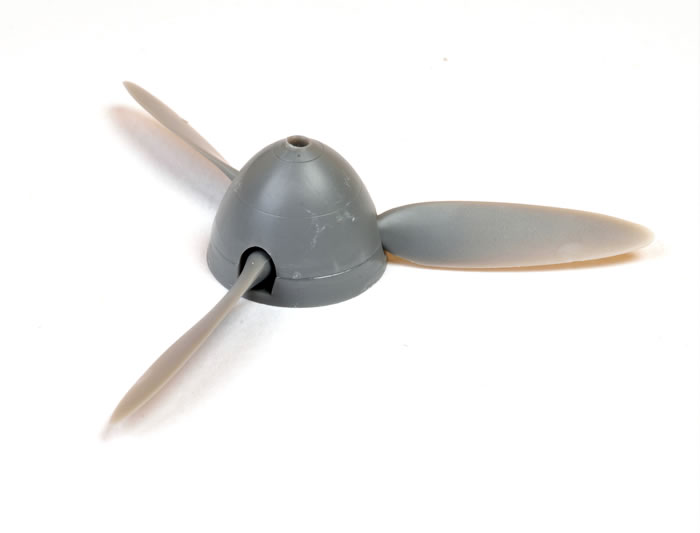
Fortunately, these are all add-on parts so if you are a full-on 109 afficiando there will be ways to address these issues by the time the kit is released.
The engineering of the kit is impressive and even unique in a number of areas. Fit is very good.
I particularly enjoyed building and painting the cockpit.
This build was straight from the box, so I kept the moulded-on harness straps even though I was not keen on them. In the end though, I was really pleased with the way they looked after careful painting. Oddly, the shoulder straps appear to disappear behind the seat pan but it will be a simple matter to add hardware and maybe a short extentsion to the straps.
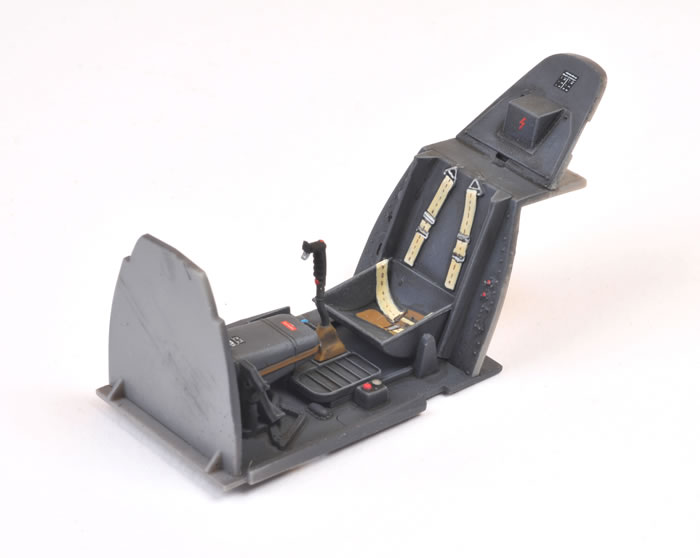
The instrument panel features raised bezels and flat circles for decal instruments that will be supplied with the production kits. As the kit decals are not yet available, I used Airscale instrument dials and placards in my cockpit.
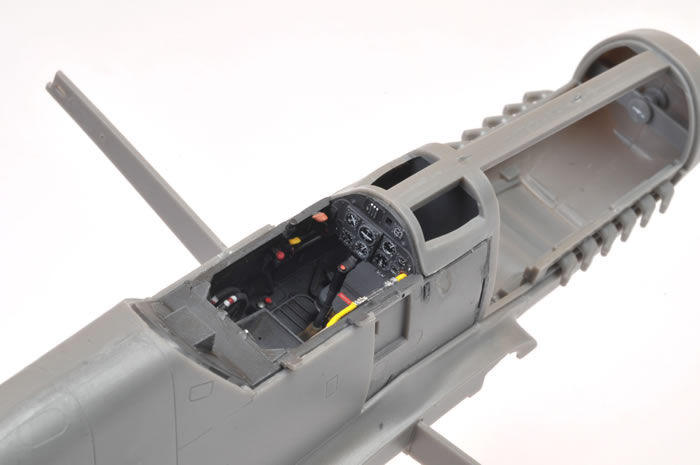
The floor and sidewalls were built as sub-assemblies, but I left off the clear fuel line to permit masking of the clear inspection panel. This was glued in place after all the cockpit painting was complete.
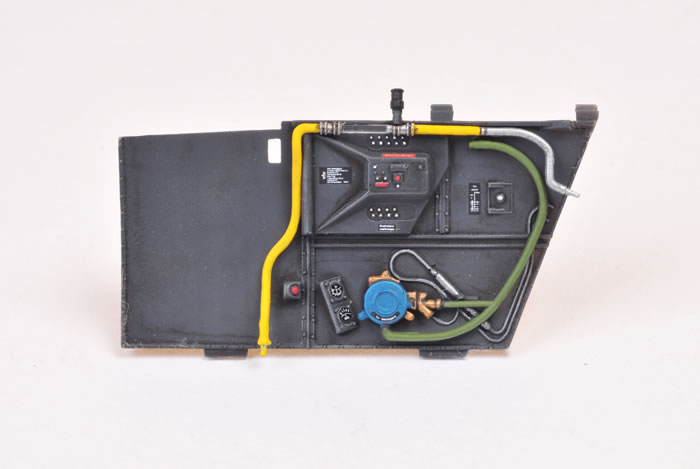
I also like that the sidewalls include the UV lights moulded to the top. Stout locating points for the open canopy are also moulded to the starboard sidewall.
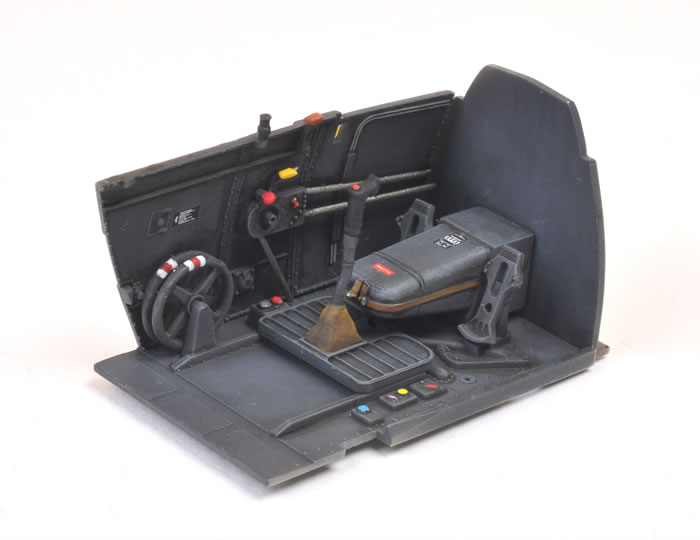
With basic construction complete, I have now handed this model over to Chris Wauchop for painting and weathering.
Hasegawa's 1/32 scale Messerschmitt Bf 109 G-6 was released in 2001 and became an instant classic. This easy to build and generally accurate kit heralded the widespread resurgence of 1/32 scale aircraft modelling.
However, Hasegawa's Gustav was not perfect. The nose appears was not quite tall enough and the spinner was misshapen. Other problem areas included the staggered nose scoops, poorly shaped oil cooler housing, stick-on upper-wing wheel bulges, undersized tail wheel and some detail missing from the cockpit, canopy and undercarriage.
Fast forward 12 years and Revell has taken a completely different approach in terms of engineering and options.
Revell's all-new 1/32 scale Messerschmitt Bf 109 G-6 presents the opportunity to build either an early G-6 with the framed canopy and short tail or a late G-6 with Erla hood and tall tail straight from the box. Subtle differences are covered by alternative parts, and outline accuracy is excellent.
Detail is clearly better than the Hasegawa kit in the areas of the cockpit, canopies, undercarriage and wheel wells.
I would give the Revell kit a narrow points victory for their surface detail too. It is crisp, very fine and subtle.
The excellent fit and the lack of complication (i.e., no engine, no gun bays etc) also makes this kit an easy and satisfying build.
The shape or detail discrepancies around the cowl bulges, propeller blades, supercharger intake and oil cooler housing are baffling, but they will not bother everyone. If they are of concern, most of the issues may already be addressed by aftermarket corrections, and those that can't now (principally the cowl bulges) almost certainly will by the time the kit is released.
So do we really need a new 1/32 scale Messerschmitt Bf 109 G-6?
Well, I am impressed. I like the engineering, the good fit, the high level of detail straight from the box, and the options to build either an early or a late G-6. In my opinion, this is a very good kit.
Considering Revell's pricing policy, you'll be able to afford a whole Staffel of Gustavs too!
Notes:
More information on Revell's 1/32 scale Bf 109 G-6 kit will be available closer to release.
The ADH Publishing book, "How to Build Revell's Messerschmitt Bf 109 G-6", will include:
-
an analysis of available Messerschmitt Bf 109 G-6 kits in 1/32 scale
-
close-up detail reference of a Bf 109 G-6 airframe
-
an exhaustive step-by-step guide to building the model straight from the box
-
a guide to improvements and super detailing
-
modelling contributions from Marcus Nicholls, Roy Sutherland, Chris Wauchop and myself
-
profile illustrations and
-
a list of references, accessories and decals
The book should be available in July 2013 and may be pre-ordered now from the ADH Books website.
Model, Images and Text
Copyright ©
2013 by Brett Green
Page Created 3 May, 2013
Last Updated
3 May, 2013
Back to HyperScale Main Page
|
Home
| What's New | Features | Gallery | Reviews | Reference | Resource Guides | Forum |